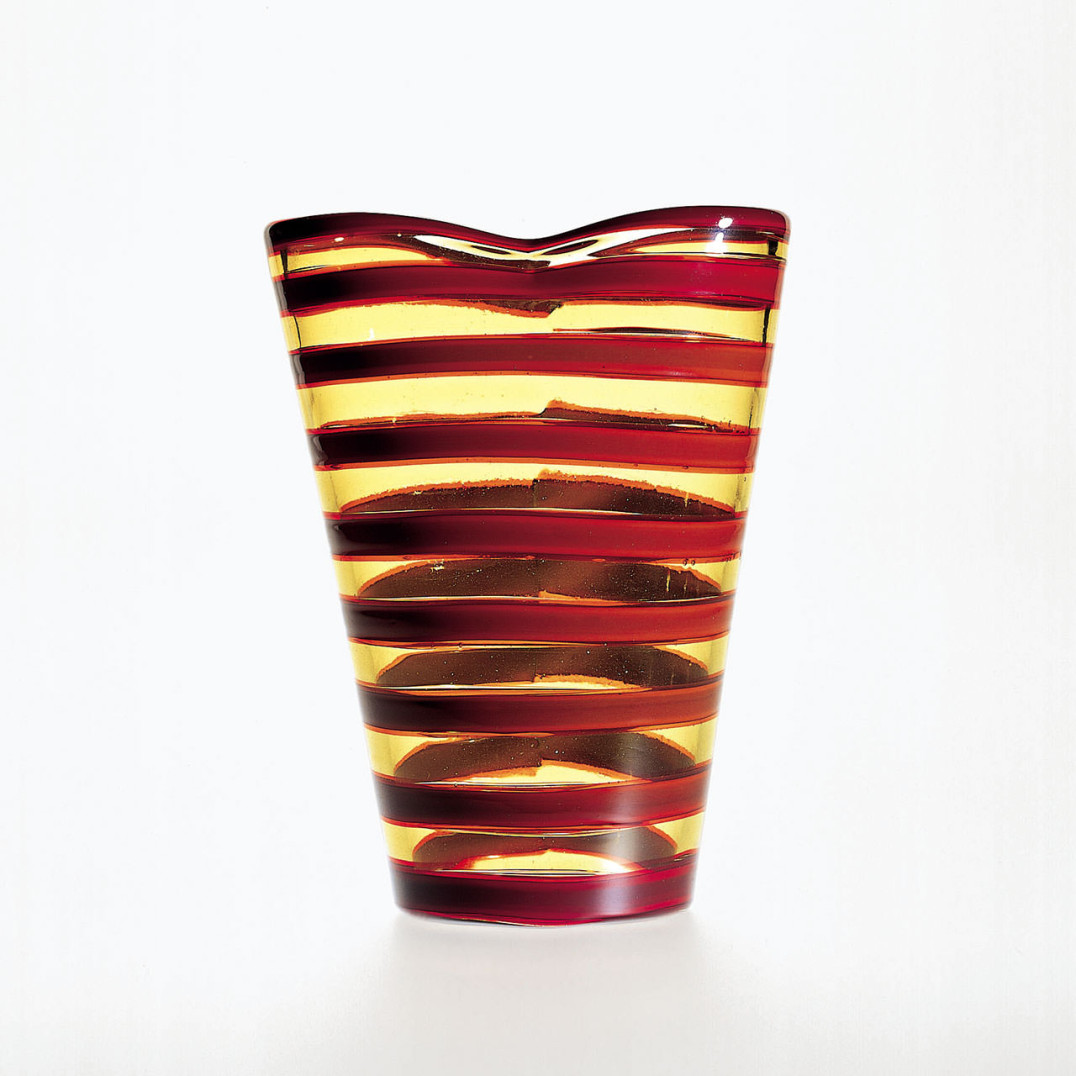
Fulvio BianconiA fasce orizzontali, 1951
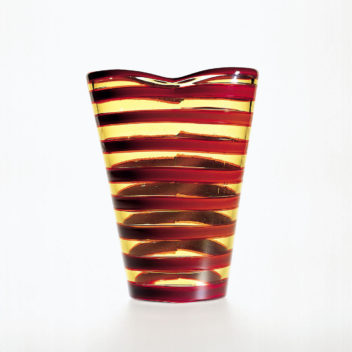
Fulvio BianconiA fasce orizzontaliVenini & C., 1951
Vase in transparent straw-colored glass decorated with orange fasce.
Acid stamped:
venini murano ITALIA.
Original paper label.
9 1/2 in. high (24.1 cm)
Exhibitions:
2000, New York, Venetian Glass, Museum of Arts & Design;
2001, Milan, Murano: Vetri dalla Collezione Olnick Spanu, Spazio Oberdan.
Bibliography and comparison texts:
Venini, grey catalogue, n. 4400;
M. Karasik, 1989, n. 17;
Olnick Spanu, 2000, n. 89;
Olnick Spanu, 2001, n. 126.
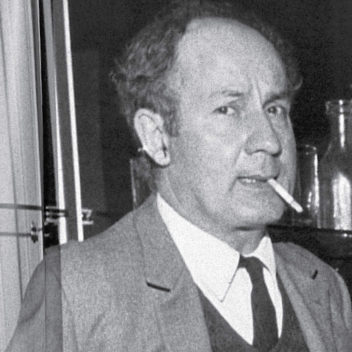
Fulvio Bianconi 1915–1996
Fulvio Bianconi was a graphic artist, caricaturist, and designer. Born in Padua, he attended the Istituto d'Arte and the Accademia di Belle Arti in Venice. He first encountered glass at age fifteen when he studied decoration with enamels under the guidance of Michele Pinto. During the late '30s, he worked as a caricaturist, graphic artist, and illustrator for various publishing houses such as Mondadori, Rizzoli, Garzanti, and others. After World War II, he came to Murano to study glass techniques and met Paolo Venini. A productive relationship ensued as he began a collaboration with Venini in 1947 that lasted through the entire decade of the '50s. One of his most characteristic works is the long series of stylized figurines which Bianconi designed at the end of the '40s, taking his inspiration from the Italian Commedia dell'Arte. His pezzati vessels proved extraordinary due to their richness in color, as were the fazzoletti, presented in several different vitreous textures, which he created with Venini himself. He obtained widespread acclaim for the a Macchie and Fasce orrizontali series, in which Bianconi revealed a marked painterly vocation. In the '50s, he worked with other workshops such as the Vetreria Cenedese, designing vessels with applications and other pieces with cased decorations. From 1958 to 1961, he designed glass pieces for I.V.R. Mazzega. In 1963, he designed for the Vetreria Vistosi. And in 1967, he began working again with Venini, creating vessels with unusual shapes such as the Informale (1968). After another contact with Venini in 1989, he designed for De Majo from 1991 to 1992.

Venini & C. 1932–2001
In 1932, when both Martinuzzi and Zecchin left the company, Paolo Venini changed the name from Vetri Soffiati Muranesi Venini & Co. (V.S.M. Venini & Co.) to Venini & C.. Milanese architect Tommaso Buzzi became the new artistic director. After 1934, artistic direction was taken on by Carlo Scarpa, who designed most of the company's production through 1947. Side by side with Venini, who often intervened personally in design, Scarpa created numerous collections of objects characterized by refined colors. After World War II, Venini & C. sought numerous collaborations with artists such as architect Giò Ponti and the Swedish-born Tyra Lundgren. After 1948, Fulvio Bianconi, Massimo Vignelli, and Tobia Scarpa contributed significantly to the new direction of the company. Paolo Venini died in 1959 and his son-in-law, Ludovico Diaz de Santillana, took over the management of Venini & C. He not only worked personally as a glass designer but also continued the collaboration started by Paolo Venini with various artists and designers. Starting in 1960, many other designers collaborated with the company, like Thomas Stearns, Toni Zuccheri, Tapio Wirkkala, Laura and Alessandro Diaz de Santillana, James Carpenter, Dan Dailey, Richard Marquis, Benjamin Moore, and Toots Zynsky. In 1986, the de Santillana family left the company, selling their stock to the Ferruzzi group, which guaranteed the fine quality Venini was known for by hiring new designers such as Timo Sarpaneva, Marco Zanini, Ettore Sottsass Jr., Alessandro Mendini, Mario Bellini, Barbara del Vicario, and others. In 1988, Venini was acquired by Royal Scandinavian. Since 2001, Venini S.p.A. has been part of Italian Luxury Industries Group and is led by Giancarlo Chimento, Giuliano Tabacchi, and Giorgio Rizzo.
Fulvio BianconiA fasce orizzontali, 1951
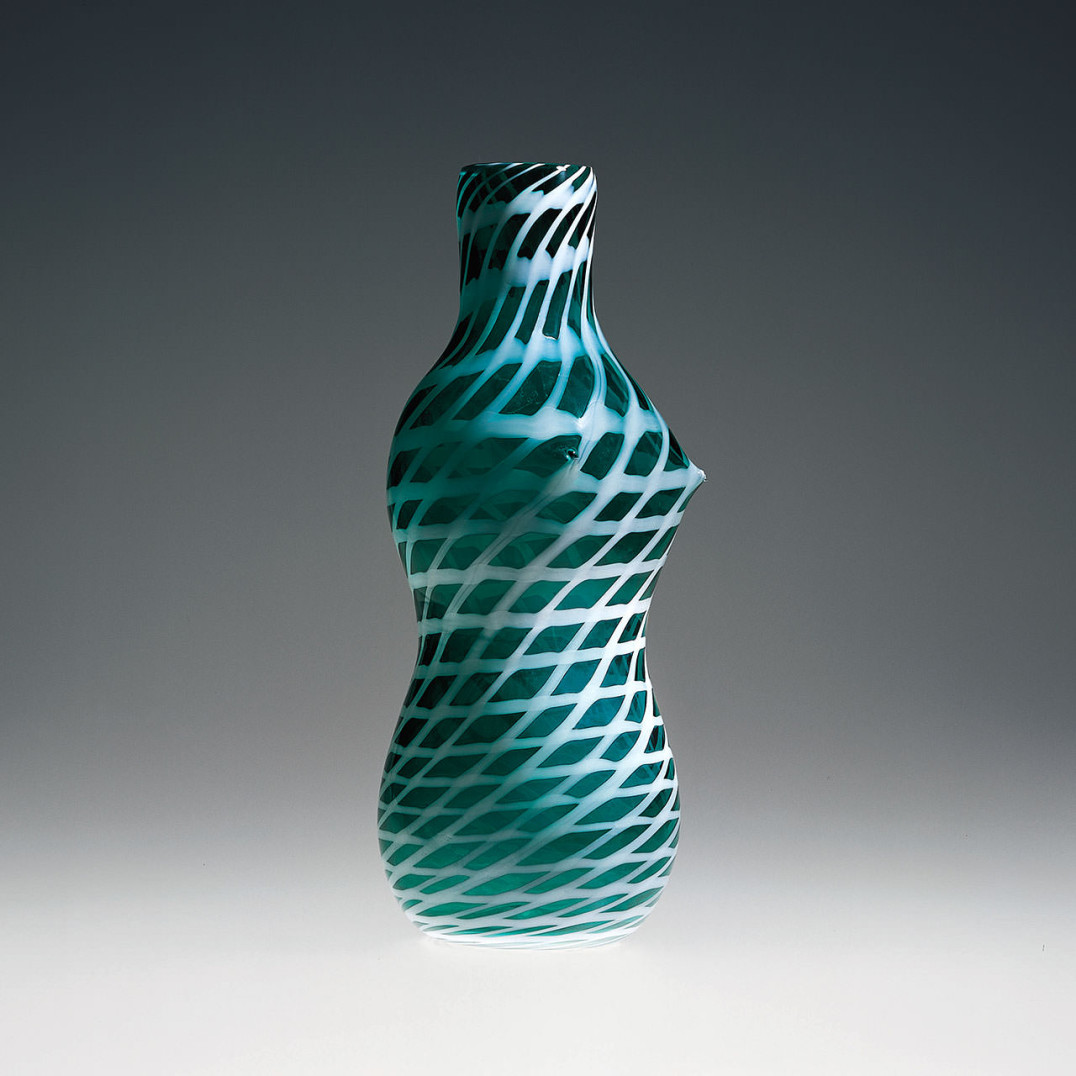
Fulvio BianconiSirena, 1950

Fulvio BianconiSirenaVenini & C., 1950
Torso-shaped vessel in transparent green glass decorated with a webbing of applied lattimo glass.
Acid stamped:
venini murano ITALIA.
Paper label: Venini murano
MADE IN ITALY.
15 1/2 in. high (39.4 cm)
Exhibitions:
2000, New York, Venetian Glass, Museum of Arts & Design;
2001, Milan, Murano: Vetri dalla Collezione Olnick Spanu, Spazio Oberdan.
Bibliography and comparative texts:
Venini, grey catalogue, n. 4209;
M. Karasik, 1989, n. 24;
R. Bossaglia, 1993, n. 43;
M. Heiremans, 1993, n. 223;
F. Deboni, 1996, n. 210;
M. Heiremans, 1996, n. 90;
H. Ricke, E. Schmitt, 1996, n. 85;
H. J. Lockwood, 1998, p. 19;
Olnick Spanu, 2000, n. 88;
Olnick Spanu, 2001, n. 125;
B. Leigh, Art & Antiques, 2003, p. 93.

Fulvio Bianconi 1915–1996
Fulvio Bianconi was a graphic artist, caricaturist, and designer. Born in Padua, he attended the Istituto d'Arte and the Accademia di Belle Arti in Venice. He first encountered glass at age fifteen when he studied decoration with enamels under the guidance of Michele Pinto. During the late '30s, he worked as a caricaturist, graphic artist, and illustrator for various publishing houses such as Mondadori, Rizzoli, Garzanti, and others. After World War II, he came to Murano to study glass techniques and met Paolo Venini. A productive relationship ensued as he began a collaboration with Venini in 1947 that lasted through the entire decade of the '50s. One of his most characteristic works is the long series of stylized figurines which Bianconi designed at the end of the '40s, taking his inspiration from the Italian Commedia dell'Arte. His pezzati vessels proved extraordinary due to their richness in color, as were the fazzoletti, presented in several different vitreous textures, which he created with Venini himself. He obtained widespread acclaim for the a Macchie and Fasce orrizontali series, in which Bianconi revealed a marked painterly vocation. In the '50s, he worked with other workshops such as the Vetreria Cenedese, designing vessels with applications and other pieces with cased decorations. From 1958 to 1961, he designed glass pieces for I.V.R. Mazzega. In 1963, he designed for the Vetreria Vistosi. And in 1967, he began working again with Venini, creating vessels with unusual shapes such as the Informale (1968). After another contact with Venini in 1989, he designed for De Majo from 1991 to 1992.

Venini & C. 1932–2001
In 1932, when both Martinuzzi and Zecchin left the company, Paolo Venini changed the name from Vetri Soffiati Muranesi Venini & Co. (V.S.M. Venini & Co.) to Venini & C.. Milanese architect Tommaso Buzzi became the new artistic director. After 1934, artistic direction was taken on by Carlo Scarpa, who designed most of the company's production through 1947. Side by side with Venini, who often intervened personally in design, Scarpa created numerous collections of objects characterized by refined colors. After World War II, Venini & C. sought numerous collaborations with artists such as architect Giò Ponti and the Swedish-born Tyra Lundgren. After 1948, Fulvio Bianconi, Massimo Vignelli, and Tobia Scarpa contributed significantly to the new direction of the company. Paolo Venini died in 1959 and his son-in-law, Ludovico Diaz de Santillana, took over the management of Venini & C. He not only worked personally as a glass designer but also continued the collaboration started by Paolo Venini with various artists and designers. Starting in 1960, many other designers collaborated with the company, like Thomas Stearns, Toni Zuccheri, Tapio Wirkkala, Laura and Alessandro Diaz de Santillana, James Carpenter, Dan Dailey, Richard Marquis, Benjamin Moore, and Toots Zynsky. In 1986, the de Santillana family left the company, selling their stock to the Ferruzzi group, which guaranteed the fine quality Venini was known for by hiring new designers such as Timo Sarpaneva, Marco Zanini, Ettore Sottsass Jr., Alessandro Mendini, Mario Bellini, Barbara del Vicario, and others. In 1988, Venini was acquired by Royal Scandinavian. Since 2001, Venini S.p.A. has been part of Italian Luxury Industries Group and is led by Giancarlo Chimento, Giuliano Tabacchi, and Giorgio Rizzo.
Fulvio BianconiSirena, 1950
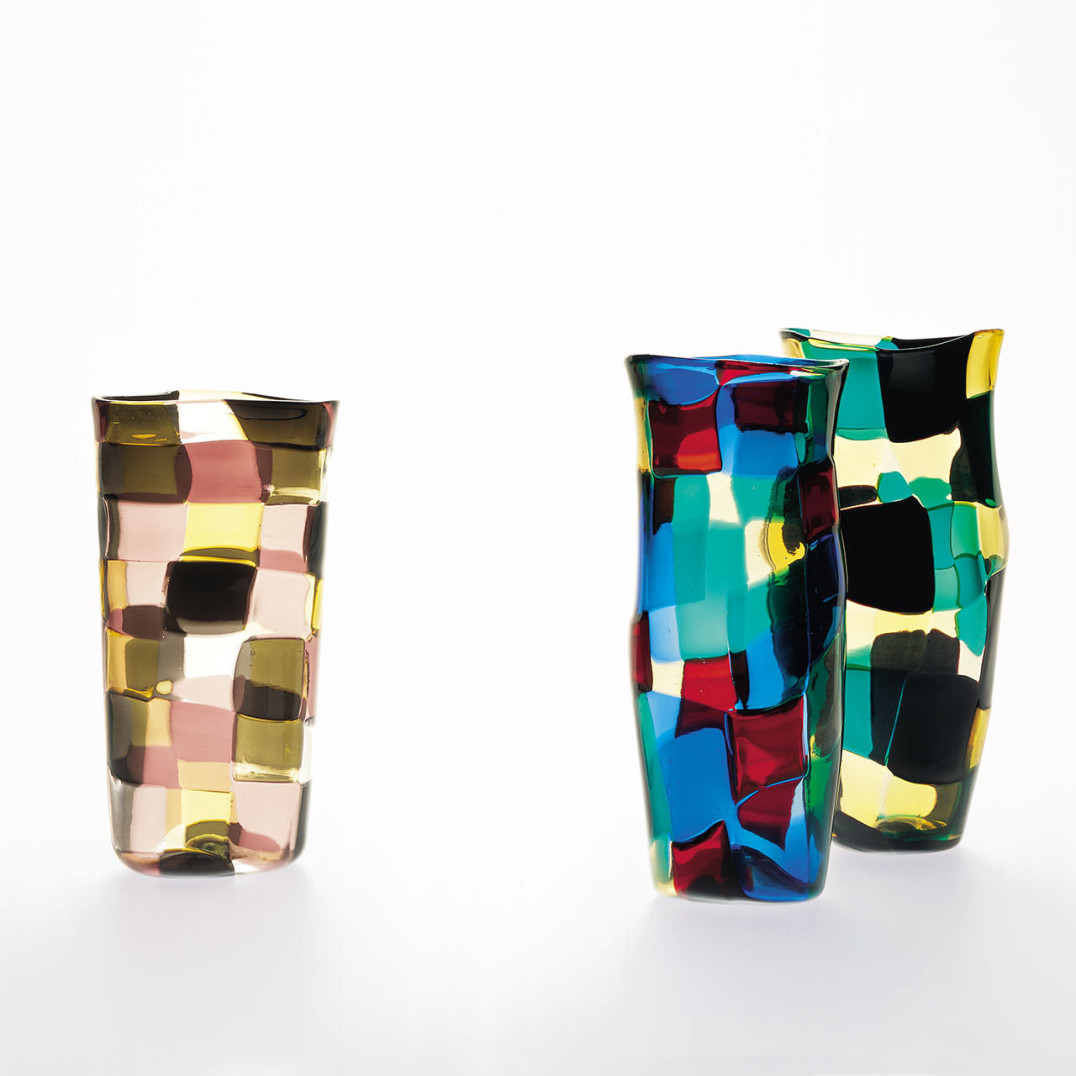
Fulvio BianconiPezzati, ca. 1951-1952
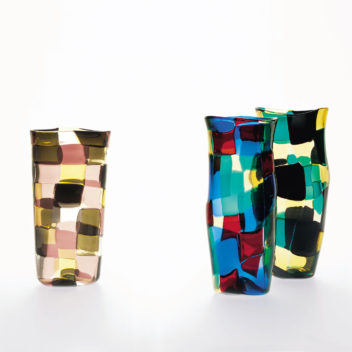
Fulvio BianconiPezzatiVenini & C., ca. 1951-1952
Three patchwork vases. The one on the left is in the Istanbul colors; the patches that compose this series are made of transparent clear, straw, and tan glass. The middle vase is in the Parigi colors; the patches that compose this series are made of transparent blue, green, clear and red glass. The vase on the right is in the Stoccolma colors; the patches that compose this series are made of transparent black, turquoise, clear, and straw glass.
Acid stamped:
venini murano ITALIA.
Paper label: n. 4916.
8 1/2 in. high (21.6 cm)
9 1/8 in. high (23.2 cm)
9 1/2 in. high (24.1 cm)
Exhibitions:
1951, Milan, 9th Triennale;
1952, Venice, 26th Biennale Internazionale d’Arte;
2000, New York, Venetian Glass, Museum of Arts & Design; 2001, Milan, Murano: Vetri dalla Collezione Olnick Spanu, Spazio Oberdan.
Bibliography and comparative texts:
Venini, grey catalogue, n. 4916, 1329;
Vetri. Quaderni…, 1951, p. 84; R. Aloi, 1955, p. 20; G. Ponti, 1959, p. 42;
W. Neuwirth, 1987, n. 35; F. Deboni, 1989, n. 107; R. Bossaglia, 1993, n. 68; M. Barovier, 1994, n. 20; M. Barovier, R. Barovier Mentasti, A. Dorigato, 1995, n. 104; H. Lockwood, 1995,
p. 8; F. Deboni, 1996, n. 214; H. Ricke, E. Schmitt, 1996, nn. 77-80; A. Venini Diaz de Santillana, 1996, nn. 145-147; A. Venini Diaz de Santillana, 2000, n. 164; Olnick Spanu, 2000, n. 87; Olnick Spanu, 2001, n. 124;
R. Losch, 2002, n. 64 Bi.

Fulvio Bianconi 1915–1996
Fulvio Bianconi was a graphic artist, caricaturist, and designer. Born in Padua, he attended the Istituto d'Arte and the Accademia di Belle Arti in Venice. He first encountered glass at age fifteen when he studied decoration with enamels under the guidance of Michele Pinto. During the late '30s, he worked as a caricaturist, graphic artist, and illustrator for various publishing houses such as Mondadori, Rizzoli, Garzanti, and others. After World War II, he came to Murano to study glass techniques and met Paolo Venini. A productive relationship ensued as he began a collaboration with Venini in 1947 that lasted through the entire decade of the '50s. One of his most characteristic works is the long series of stylized figurines which Bianconi designed at the end of the '40s, taking his inspiration from the Italian Commedia dell'Arte. His pezzati vessels proved extraordinary due to their richness in color, as were the fazzoletti, presented in several different vitreous textures, which he created with Venini himself. He obtained widespread acclaim for the a Macchie and Fasce orrizontali series, in which Bianconi revealed a marked painterly vocation. In the '50s, he worked with other workshops such as the Vetreria Cenedese, designing vessels with applications and other pieces with cased decorations. From 1958 to 1961, he designed glass pieces for I.V.R. Mazzega. In 1963, he designed for the Vetreria Vistosi. And in 1967, he began working again with Venini, creating vessels with unusual shapes such as the Informale (1968). After another contact with Venini in 1989, he designed for De Majo from 1991 to 1992.

Venini & C. 1932–2001
In 1932, when both Martinuzzi and Zecchin left the company, Paolo Venini changed the name from Vetri Soffiati Muranesi Venini & Co. (V.S.M. Venini & Co.) to Venini & C.. Milanese architect Tommaso Buzzi became the new artistic director. After 1934, artistic direction was taken on by Carlo Scarpa, who designed most of the company's production through 1947. Side by side with Venini, who often intervened personally in design, Scarpa created numerous collections of objects characterized by refined colors. After World War II, Venini & C. sought numerous collaborations with artists such as architect Giò Ponti and the Swedish-born Tyra Lundgren. After 1948, Fulvio Bianconi, Massimo Vignelli, and Tobia Scarpa contributed significantly to the new direction of the company. Paolo Venini died in 1959 and his son-in-law, Ludovico Diaz de Santillana, took over the management of Venini & C. He not only worked personally as a glass designer but also continued the collaboration started by Paolo Venini with various artists and designers. Starting in 1960, many other designers collaborated with the company, like Thomas Stearns, Toni Zuccheri, Tapio Wirkkala, Laura and Alessandro Diaz de Santillana, James Carpenter, Dan Dailey, Richard Marquis, Benjamin Moore, and Toots Zynsky. In 1986, the de Santillana family left the company, selling their stock to the Ferruzzi group, which guaranteed the fine quality Venini was known for by hiring new designers such as Timo Sarpaneva, Marco Zanini, Ettore Sottsass Jr., Alessandro Mendini, Mario Bellini, Barbara del Vicario, and others. In 1988, Venini was acquired by Royal Scandinavian. Since 2001, Venini S.p.A. has been part of Italian Luxury Industries Group and is led by Giancarlo Chimento, Giuliano Tabacchi, and Giorgio Rizzo.
Fulvio BianconiPezzati, ca. 1951-1952
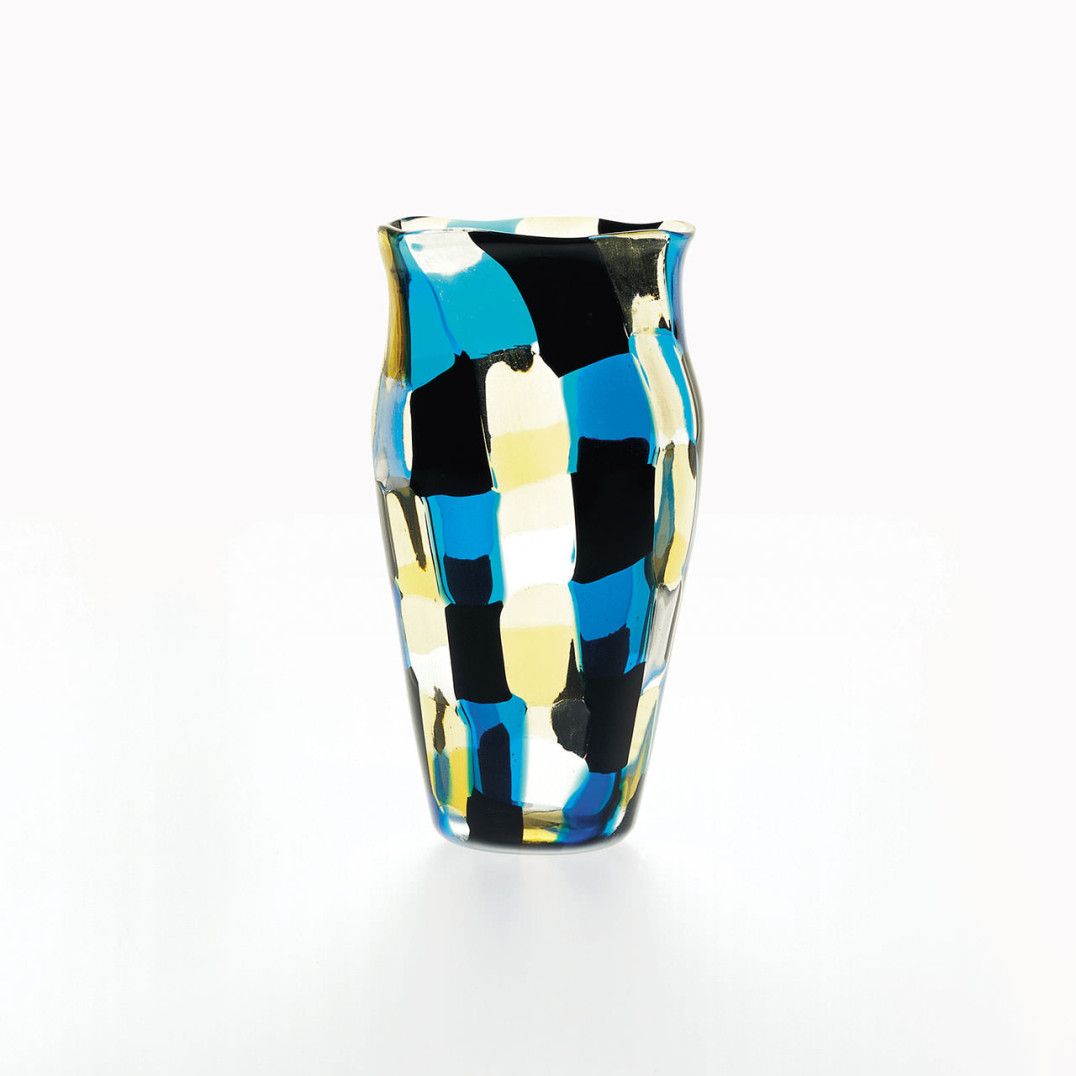
Fulvio BianconiPezzato, 1950-1951
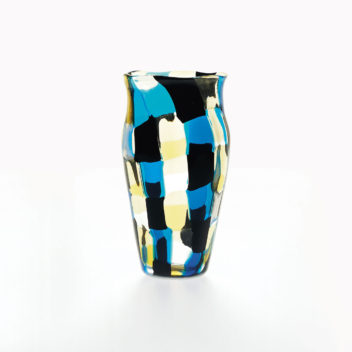
Fulvio BianconiPezzatoVenini & C., 1950-1951
Patchwork vase, the patches that compose this pezzato made of transparent glass and opaque pasta vitrea in the colors of black, turquoise, clear, and straw.
Acid stamped:
venini murano ITALIA.
9 7/16 in. high (24 cm)
Exhibitions:
1951, Milan, 9th Triennale;
1952, Venice, 26th Biennale Internazionale d’Arte;
2000, New York, Venetian Glass, Museum of Arts & Design;
2001, Milan, Murano: Vetri dalla Collezione Olnick Spanu, Spazio Oberdan.
Bibliography and comparative texts:
Venini, grey catalogue, n. 1329;
Olnick Spanu, 2000, n. 86;
Olnick Spanu, 2001, n. 123.

Fulvio Bianconi 1915–1996
Fulvio Bianconi was a graphic artist, caricaturist, and designer. Born in Padua, he attended the Istituto d'Arte and the Accademia di Belle Arti in Venice. He first encountered glass at age fifteen when he studied decoration with enamels under the guidance of Michele Pinto. During the late '30s, he worked as a caricaturist, graphic artist, and illustrator for various publishing houses such as Mondadori, Rizzoli, Garzanti, and others. After World War II, he came to Murano to study glass techniques and met Paolo Venini. A productive relationship ensued as he began a collaboration with Venini in 1947 that lasted through the entire decade of the '50s. One of his most characteristic works is the long series of stylized figurines which Bianconi designed at the end of the '40s, taking his inspiration from the Italian Commedia dell'Arte. His pezzati vessels proved extraordinary due to their richness in color, as were the fazzoletti, presented in several different vitreous textures, which he created with Venini himself. He obtained widespread acclaim for the a Macchie and Fasce orrizontali series, in which Bianconi revealed a marked painterly vocation. In the '50s, he worked with other workshops such as the Vetreria Cenedese, designing vessels with applications and other pieces with cased decorations. From 1958 to 1961, he designed glass pieces for I.V.R. Mazzega. In 1963, he designed for the Vetreria Vistosi. And in 1967, he began working again with Venini, creating vessels with unusual shapes such as the Informale (1968). After another contact with Venini in 1989, he designed for De Majo from 1991 to 1992.

Venini & C. 1932–2001
In 1932, when both Martinuzzi and Zecchin left the company, Paolo Venini changed the name from Vetri Soffiati Muranesi Venini & Co. (V.S.M. Venini & Co.) to Venini & C.. Milanese architect Tommaso Buzzi became the new artistic director. After 1934, artistic direction was taken on by Carlo Scarpa, who designed most of the company's production through 1947. Side by side with Venini, who often intervened personally in design, Scarpa created numerous collections of objects characterized by refined colors. After World War II, Venini & C. sought numerous collaborations with artists such as architect Giò Ponti and the Swedish-born Tyra Lundgren. After 1948, Fulvio Bianconi, Massimo Vignelli, and Tobia Scarpa contributed significantly to the new direction of the company. Paolo Venini died in 1959 and his son-in-law, Ludovico Diaz de Santillana, took over the management of Venini & C. He not only worked personally as a glass designer but also continued the collaboration started by Paolo Venini with various artists and designers. Starting in 1960, many other designers collaborated with the company, like Thomas Stearns, Toni Zuccheri, Tapio Wirkkala, Laura and Alessandro Diaz de Santillana, James Carpenter, Dan Dailey, Richard Marquis, Benjamin Moore, and Toots Zynsky. In 1986, the de Santillana family left the company, selling their stock to the Ferruzzi group, which guaranteed the fine quality Venini was known for by hiring new designers such as Timo Sarpaneva, Marco Zanini, Ettore Sottsass Jr., Alessandro Mendini, Mario Bellini, Barbara del Vicario, and others. In 1988, Venini was acquired by Royal Scandinavian. Since 2001, Venini S.p.A. has been part of Italian Luxury Industries Group and is led by Giancarlo Chimento, Giuliano Tabacchi, and Giorgio Rizzo.
Fulvio BianconiPezzato, 1950-1951
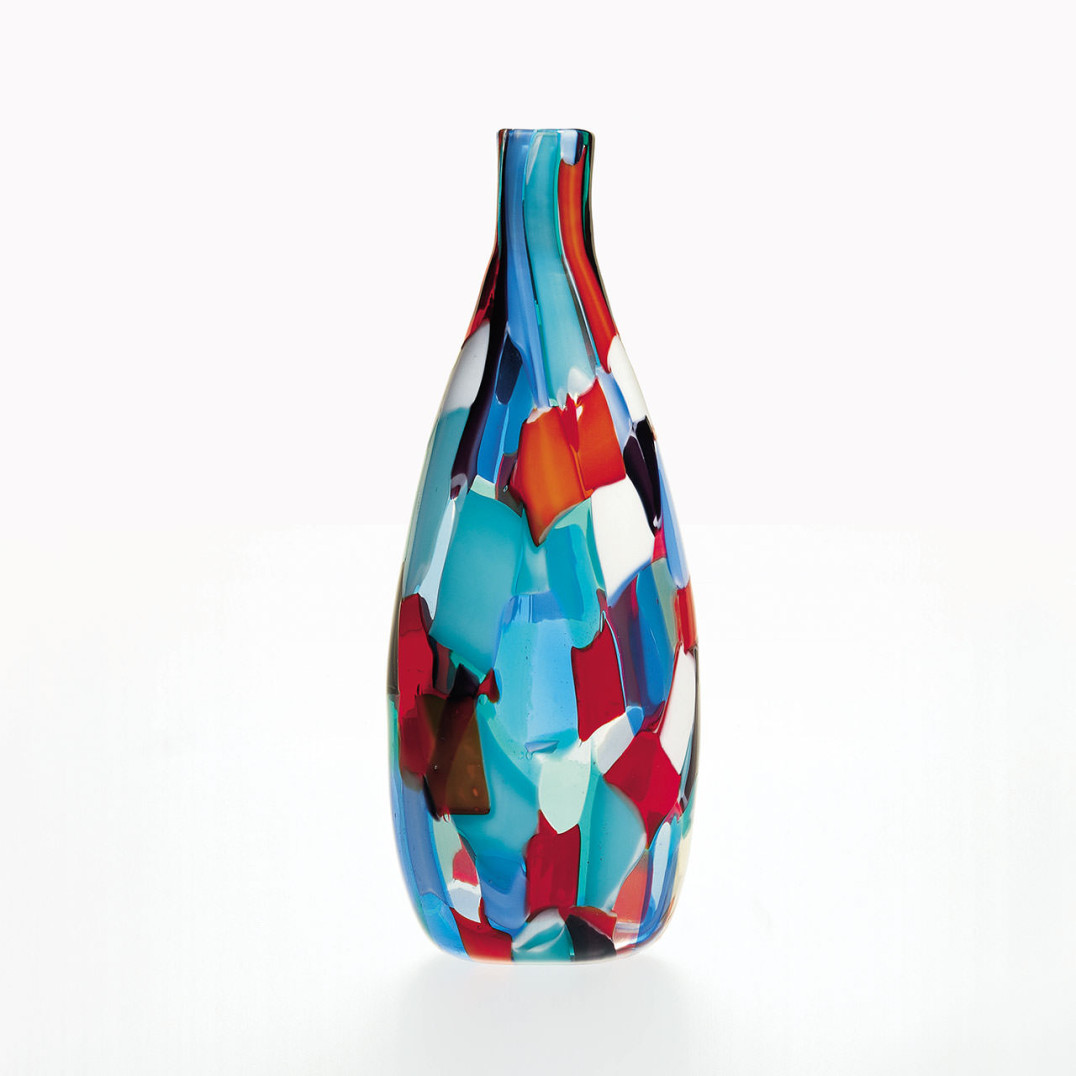
Fulvio BianconiPezzato, 1951
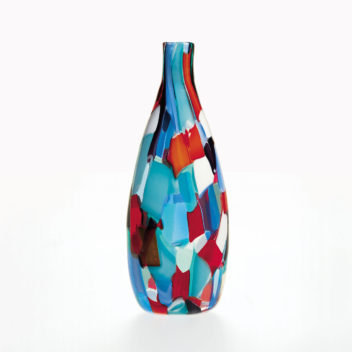
Fulvio BianconiPezzatoVenini & C., 1951
Patchwork vase, the patches that compose this pezzato made of transparent glass and opaque pasta vitrea in the colors of red, white, green, and shades of blue.
Acid stamped:
venini murano ITALIA.
14 9/16 in. high (37 cm)
Exhibitions:
1951, Milan, 9th Triennale;
2000, New York, Venetian Glass, Museum of Arts & Design;
2001, Milan, Murano: Vetri dalla Collezione Olnick Spanu, Spazio Oberdan.
Bibliography and comparative texts:
Venini, grey catalogue, n. 4319;
Domus, 1950, p. 251;
Vetri. Quaderni…, 1951, p. 84;
R. Aloi, 1952, n. 29;
R. Aloi, 1955, p. 20;
L’arte del vetro, 1992, n. 358;
R. Bossaglia, 1993, nn. 53, 54;
M. Barovier, 1994, n. 21;
F. Deboni, 1996, n. 215;
H. Ricke, E. Schmitt, 1996, n. 83;
Venini Venezia, 1998, p. 71;
H. Lockwood, 1995, p. 8;
Olnick Spanu, 2000, n. 85;
Olnick Spanu, 2001, n. 122;
R. Losch, 2002, n. 72 Bi;

Fulvio Bianconi 1915–1996
Fulvio Bianconi was a graphic artist, caricaturist, and designer. Born in Padua, he attended the Istituto d'Arte and the Accademia di Belle Arti in Venice. He first encountered glass at age fifteen when he studied decoration with enamels under the guidance of Michele Pinto. During the late '30s, he worked as a caricaturist, graphic artist, and illustrator for various publishing houses such as Mondadori, Rizzoli, Garzanti, and others. After World War II, he came to Murano to study glass techniques and met Paolo Venini. A productive relationship ensued as he began a collaboration with Venini in 1947 that lasted through the entire decade of the '50s. One of his most characteristic works is the long series of stylized figurines which Bianconi designed at the end of the '40s, taking his inspiration from the Italian Commedia dell'Arte. His pezzati vessels proved extraordinary due to their richness in color, as were the fazzoletti, presented in several different vitreous textures, which he created with Venini himself. He obtained widespread acclaim for the a Macchie and Fasce orrizontali series, in which Bianconi revealed a marked painterly vocation. In the '50s, he worked with other workshops such as the Vetreria Cenedese, designing vessels with applications and other pieces with cased decorations. From 1958 to 1961, he designed glass pieces for I.V.R. Mazzega. In 1963, he designed for the Vetreria Vistosi. And in 1967, he began working again with Venini, creating vessels with unusual shapes such as the Informale (1968). After another contact with Venini in 1989, he designed for De Majo from 1991 to 1992.

Venini & C. 1932–2001
In 1932, when both Martinuzzi and Zecchin left the company, Paolo Venini changed the name from Vetri Soffiati Muranesi Venini & Co. (V.S.M. Venini & Co.) to Venini & C.. Milanese architect Tommaso Buzzi became the new artistic director. After 1934, artistic direction was taken on by Carlo Scarpa, who designed most of the company's production through 1947. Side by side with Venini, who often intervened personally in design, Scarpa created numerous collections of objects characterized by refined colors. After World War II, Venini & C. sought numerous collaborations with artists such as architect Giò Ponti and the Swedish-born Tyra Lundgren. After 1948, Fulvio Bianconi, Massimo Vignelli, and Tobia Scarpa contributed significantly to the new direction of the company. Paolo Venini died in 1959 and his son-in-law, Ludovico Diaz de Santillana, took over the management of Venini & C. He not only worked personally as a glass designer but also continued the collaboration started by Paolo Venini with various artists and designers. Starting in 1960, many other designers collaborated with the company, like Thomas Stearns, Toni Zuccheri, Tapio Wirkkala, Laura and Alessandro Diaz de Santillana, James Carpenter, Dan Dailey, Richard Marquis, Benjamin Moore, and Toots Zynsky. In 1986, the de Santillana family left the company, selling their stock to the Ferruzzi group, which guaranteed the fine quality Venini was known for by hiring new designers such as Timo Sarpaneva, Marco Zanini, Ettore Sottsass Jr., Alessandro Mendini, Mario Bellini, Barbara del Vicario, and others. In 1988, Venini was acquired by Royal Scandinavian. Since 2001, Venini S.p.A. has been part of Italian Luxury Industries Group and is led by Giancarlo Chimento, Giuliano Tabacchi, and Giorgio Rizzo.